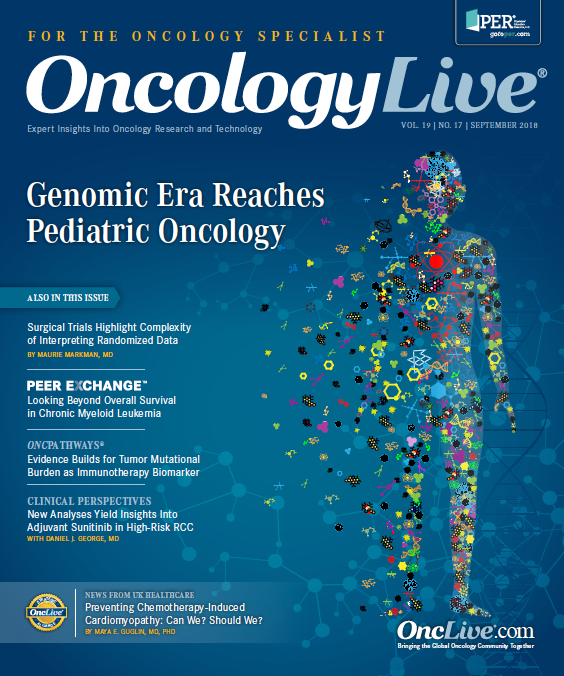Publication
Article
Oncology Live®
Frontline Quizartinib Is Tested in AML Subgroup
Author(s):
Quizartinib, a small molecule receptor tyrosine kinase inhibitor targeting FLT3, is currently being evaluated in combination with chemotherapy in patients with newly diagnosed FLT3-ITD–positive AML.
Antoine Yver, MD

Antoine Yver, MD
Patients with acute myeloid leukemia (AML) who harbor a FLT3-ITD mutation historically have had a poor prognosis. Quizartinib, a small molecule receptor tyrosine kinase inhibitor targeting FLT3, has shown promise as a single agent in the relapsed/refractory setting and is currently being evaluated in combination with chemotherapy in patients with newly diagnosed FLT3-ITD—positive AML in the QuANTUM-First study (NCT02668653).1
The global, randomized, double-blind, placebocontrolled, phase III study is comparing quizartinib with standard induction and consolidation chemotherapy with placebo with standard induction and consolidation chemotherapy. Quizartinib is then administered as maintenance therapy alone compared with maintenance with placebo alone. The primary endpoint of QuANTUM-First is eventfree survival, with secondary endpoints of overall survival (OS), complete remission (CR) at the end of the first induction cycle, and composite CR rate after the first induction cycle (Figure).
“The hypothesis is that by adding quizartinib to the standard of care, we would improve the overall outcome of patients,” Antoine Yver, MD, MSc, executive vice president and global head, Oncology Research and Development, Daiichi Sankyo, said in an interview with OncologyLive®.
QuANTUM-First is currently enrolling participants. The experimental arm of the trial consists of up to 2 cycles of induction chemotherapy with cytarabine and daunorubicin or idarubicin followed by quizartinib, up to 4 cycles of consolidation with cytarabine then quizartinib alone or quizartinib and a hematopoietic stem cell transplant (HSCT), and maintenance consisting of up to 12 cycles of quizartinib.
Inclusion criteria are a newly diagnosed morphologically documented primary AML or AML secondary to myelodysplastic syndrome or a myeloproliferative neoplasm, ECOG performance status of 0 to 2, presence of a FLT3-ITD mutation in the bone marrow, administration of standard induction chemotherapy, adequate renal and hepatic function, and serum electrolytes within normal limits.
Exclusion criteria include prior quizartinib or other FLT3-ITD inhibitor treatment, history of known central nervous system leukemia, uncontrolled cardiovascular disease, active hepatitis B or C, HIV, and active acute or chronic systemic fungal, bacterial, or viral infection that is not well controlled.
Figure. Quizartinib in Newly Diagnosed FLT3-ITD-Positive AML
Efficacy Data in the Relapse
In August 2018, the FDA granted a breakthrough therapy designation to quizartinib for the treatment of adult patients with relapsed/ refractory FLT3-ITD—positive AML, based on data from the QuANTUM-R trial.Phase III findings with quizartinib monotherapy from QuANTUM-R were presented at the 2018 European Hematology Association (EHA) Congress.2 The FLT3 inhibitor reduced the risk of disease progression or death by 24% compared with salvage chemotherapy in patients with FLT3-ITD—positive relapsed/refractory disease after first-line treatment with or without HSCT.
These data confirmed the efficacy and safety of quizartinib in this population, showing that at a median follow-up of 23.5 months, the median OS with quizartinib was 6.2 months (95% CI, 5.2-7.2) compared with 4.7 months (95% CI, 4.0-5.5) with salvage chemotherapy (HR, 0.76; 95% CI, 0.58- 0.98; stratified log-rank test, 1-sided P = .0177). Patients on this study were randomized 2:1 to either quizartinib daily at 60 mg, with a lead-in of 30 mg, or to investigator’s choice of salvage chemotherapy.
Yver said that one of the questions leading up to the presentation of the QuANTUM-R results was the unpredictability of the drug. “The drug has been in development for a while,” acknowleged Yver. “But QuANTUM-R proved that the drug can be given as predicted. We observed a 90% relative dose intensity, which is a very objective measure of the fact that it can be given as predicted. Most cancer drugs are around 85% to 95%, so that is a very reassuring measure of the ability to use a regimen like this in a difficult setting.”
This was the first trial to show improved OS in relapsed/refractory FLT3-ITD—mutated AML, according to Jorge E. Cortes MD, lead investigator on the QuANTUM-R study, who presented the findings at the EHA meeting. “These pivotal data confirm that targeting FLT3-ITD with this potent new therapy may be of significant clinical value,” said Cortes. deputy chair and professor in the Leukemia Department of The University of Texas MD Anderson Cancer Center in Houston.
Patients with the FLT3-ITD mutation make up approximately 25% of all AML cases, and there is a shortage of therapies for this population. Yver concluded that considering the data up until this point, quizartinib has the potential to be a major player in AML.
“QuANTUM-R proved the clinical benefit for patients who have relapsed/refractory FLT3-ITD— mutated AML,” said Yver. “Different doses and regimens tested consistently showed that in first or second salvage in relapsed/refractory AML, response rates are high. Putting someone into response after relapse is beneficial immediately.”
References
- Schlenk R, Dombret H, Amadori S, et al. QuANTUM-First: phase 3, double-blind, placebo-controlled study of quizartinib in combination with induction and consolidation chemotherapy, and as maintenance therapy in patients (pts) with newly diagnosed (NDx) FLT3-ITD acute myeloid leukemia (AML). Ann Oncol. 2017;28(suppl 5; abstr 1040TiP). academic.oup.com/annonc/article/28/suppl_5/mdx373.046/4109125.
- Cortes J, Khaled S, Martinelli G, et al. Quizartinib significantly prolongs overall survival in patients with FLT3-internal tandem duplication—mutated (MUT) relapsed/refractory AML in the phase 3, randomized, controlled QuANTUM-R trial. Presented at: 2018 EHA Congress; June 14-17, 2018; Stockholm, Sweden. Abstract LB2600. learningcenter.ehaweb.org/eha/2018/stockholm/218882/jorge.cortes.quizartinib.significantly.prolongs.overall.survival.in.patients.html.
























%20(2)%201-Recovered-Recovered-Recovered-Recovered-Recovered-Recovered-Recovered-Recovered-Recovered-Recovered-Recovered-Recovered-Recovered-Recovered-Recovered-Recovered-Recovered.jpg?fit=crop&auto=format)
%20(2)%201-Recovered-Recovered-Recovered-Recovered-Recovered-Recovered-Recovered-Recovered-Recovered-Recovered-Recovered-Recovered-Recovered-Recovered-Recovered-Recovered-Recovered.jpg?fit=crop&auto=format)
